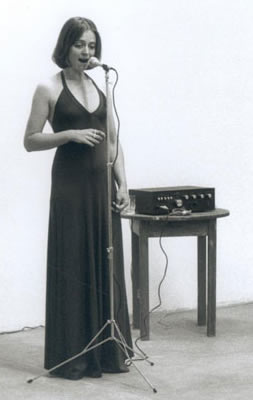

photo Roberto Masotti
WHEN MY FEET FELT THE PATH THAT MY EYES COULD NOT SEE
is the first in a series of works for chorus begun in 1992. These works are
free settings of text fragments from John Cage's "I-VI", created
for the Charles Eliot Norton Lecture series at Harvard University 1988-89.
Drawing from over 30 sources including Wittgenstein, Beckett, McLuhan, Schoenberg,
Thoreau, Emerson, the Wall St. Journal, NY Times etc. and his own writings,
Cage, via a complex computer program, assembled his six mesostic texts. About
these Cage notes: "In the language of these lectures, syntax may appear
or not. generally it doesn't. Words in fact can appear by themselves. The
have-nots of language, what the chinese call empty words, particles, connectives
etc. have a position equal to full words. Repetition is a characteristic of
this work, as it is, Schoenberg said of music."
My intervention on these texts has none of the rigor of Cage's original monumental
structuring, on the contrary I sifted through these texts at random looking
for lines I "liked" and then reduced them largely to their monosyllabic
components which would serve the needs of music itself- almost exclusively
chordal, repetitive, recombinations of the first four chords (A7,B7,F7,D7).
In any case I was convinced that there was a harmonius agreement between the
two. I was in fact in August '92, that I was about to send John a first draft
of the score for his approval, when I got word of his death. So there Iwas,
with an unsollicited and unwanted 'in memoriam' in hand, for one of our greatest
family members.
The music is self explanatory. I have been experimenting with triadic harmony for over 20 years, in an attempt to invent a language within a language - the one which is closer to the one I speak. So I take these indestructable (biologically nondegradable) sonic icons, and put them into my homemade particle accelerator to observe if, in fact, they contain the essence of anything (physical, philosophical, nutritional). Are their half-lives beyond human reckoning? Do these ubiquitous and orderly european soundbytes in any way portend future disorder? In the meanwhile we can be assured that a triad is a triad. Such is the verity of mother's milk. As in much recent chamber music a single tone dominates (in this case "a" ) which becomes the common hinge tone for most of the chords - opposing tonal areas appear from time to time as do real musical slips of the tongue where hints of common expressive tendencies appear. Thus the music slips nonchalantly in an out of purist rigor and harvest moons.
When Joan La Barbara asked me to create a version of this work for her, I wasn't sure if it could be done, but I thought the easiest way would be for Joan's voice to become the Chorus as well as the soloist (obbligato, which is written into the score). With digital samples of her voice my assistant Jonathan Mitchell and I recreated the entire score with Joan singing all the parts (mostly four). To this end I created a distinctly "electronic sounding" chorus against which joans warm and pure human sound is offset. Here, she is free to sing in an out of sync with herself, weaving lines derived from any of the four parts. I agreed to substitute the original trumpet and percussion obbligati with the chinese instruments present in this concert which will function like intermittent spontaneous commentary around the central vocal material.
Alvin Curran February 1996